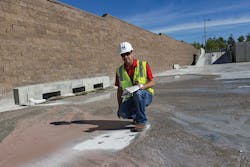Following the early 2019 Midwest flooding, Zachary Jilek’s company, E&A Consulting Group—a planning, engineering, environmental, and field services company in Omaha, NE—had difficulties accessing sites for erosion control inspections or to view the damage. “A lot of our jobs in the Omaha metro area held up pretty good; I don’t know if it was because of our flood reduction levees and ponds,” notes Jilek, CPESC, CISEC, environmental services department manager for the company. While the frozen ground meant some homes and cornfields flooded on days when rain could not infiltrate, it also didn’t allow for erosion. Still, silt and clay soils present ongoing challenges, such as revegetation after topsoil is stripped. “When we move from erosion control to post-construction, we run into problems with our clay soils clogging underdrains not properly protected. We end up with a lot of ponding,” says Jilek. Work also must meet both local and state Department of Environmental Quality permits. While he’s aware of new technologies such as drones, the local developers are “price conscious,” says Jilek. “I run into problems because we’re very detailed. My inspectors walk every silt fence, check every basin, measure silt depths, check streets for silt, make maintenance plans,” he says. Jilek uses Omaha’s website as a guidance document. “What’s made me successful is when the EPA came through here, I knew what they wanted. Until they get a fine, people don’t know what they are doing incorrectly.”
What He Does Day to Day
Jilek’s daily responsibilities entail supervising seven environmental scientists and engineers with a revenue stream exceeding $1 million. The team designs, permits, monitors, and reports systems for compliance with local, state, and federal regulations with a full line of erosion and sediment control services. “I want to make sure they’re successful in what they do and be available for questions and guidance,” says Jilek, who also does marketing, business development, proposal preparations, billing, and financial accountability.
What Led Him to This Line of Work
While earning a B.S. degree in construction engineering technology at the University of Nebraska at Omaha and Lincoln, Jilek worked part-time as an AutoCAD technician/construction manager for Omaha Public Schools. His first job with a civil engineering company involved working in the soils lab and construction inspection. The city of Omaha required erosion control inspections be uploaded to its website, and Jilek gained erosion control knowledge. He began work for E&A in 2004, forming its environmental services department to help the company’s clients meets erosion control and stormwater pollution prevention plan (SWPPP) requirements.
What He Likes Best About His Work
Jilek enjoys the flexibility. “I go from doing industrial stormwater work at a meat packing plant to a concrete plant to erosion control inspections at a residential subdivision and then to a commercial job doing erosion control inspections to a phase 1 ESA,” he says. “I like both the field and office components.”
His Greatest Challenge
Balancing compliance and keeping clients happy is challenging, Jilek notes. “They want their job to be in compliance, but we’re spending their money for maintaining BMPs and maintenance. I take the approach of ‘We’ll try this first, and if it doesn’t work, we’ll go to this.’ Act like you’re spending your own money. Many developers we work with see it as an unnecessary evil. They have a permit. They have to pay us to do inspections and maintenance. There’s a lack of enforcement at times where everybody is not on an equal playing field because local compliance is driven for compliance assistance and not fining people, but the EPA or DEQ comes in and fines people. Informing clients of new regulations is difficult. They’re used to doing it the old way. They used to have silt basins—we’d excavate the silt, recompact them, build the lot up, and they could build houses on them. But now the basins are being moved out and converted to post-construction to treat and retain the first half-inch of runoff, and they’re on buildable lots. It involves explaining to developers as well as people buying the houses [that] it’s not going to be a mosquito trap.”






